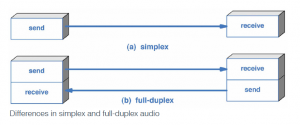Home > BLOG CENTER > Audio Endpoint in conference system
Home > BLOG CENTER > Audio Endpoint in conference system
Today, most audio conferencing endpoint products (speakers, microphones, and audio mixing controls) are full-duplex systems, providing the same kind of interaction one gets from the telephone, with important improvements.

Users can interrupt one another at any time, speaking and hearing simultaneously (known as a full-duplex call), and both users can be heard simultaneously without echo (call feedback often caused by speaker/microphone placement). Communication seems as natural as being with the person in the same room.
A properly chosen and configured full-duplex conferencing endpoint will ensure that high-quality audio is captured atthe endpoint even when the room is reverberant or contains noise sources like a projector, HVAC noise, outside traffic, etc. Audio conferencing endpoints can be categorized as personal conferencing devices, tabletop conference speakerphones, and professionally-installed conferencing systems. Personal conferencing devices include one or more microphones, a speaker, and signal processors. They are designed to be used by a small group of people (one to four). Tabletop conference phones have a built-in speaker that can produce a higher sound output volume than the personal conferencing products, and they may also support expansion of the microphone pickup area through the use of expansion microphones or attachment of conference phones. Professionally installed audio systems offered today support arrays of microphones that can be placed around a large conference table to handle large groups of participants. The microphones used by professionally installed systems are generally permanently installed in the conference table or on the ceiling. There are also wireless microphone systems that are designed to use with professionally installed audio conferencing systems.
The electronics that support full-duplex audio systems process audio signals to separate the signal that originates from a local person speaking into a microphone from the sound coming from a far end talker that is played through the local speakers and is subsequently coupled into the local microphone. This is called Acoustic Echo Cancellation (AEC). Professionally installed audio systems may also include an additional technology called feedback cancellation. A feedback canceller may be required when a presenter needs his/her voice amplified into a local conference space so listeners, who may be in the same large room or auditorium, can still clearly hear the presenter’s voice. Amplification of the local presenter’s voice in the local room may result in a high-pitched squealing sound called feedback if there is positive gain between the microphone and the speaker.
For a very large auditorium, a professionally installed system may also need to include a time delay function that delays the local presenter’s voice by a programmable amount. This allows an installer to guarantee that a listener at the back of a large auditorium does not hear the presenter’s amplified voice (which is transmitted at the speed of electrical signals through the audio systems) followed by a delayed version of the presenter’s live voice (which takes longer to reach that person due to the fact that the acoustic sound travels more slowly than the electronically captured version of the presenter’s voice).
40088 41166info@meeteasy.com.hk
3/F,Building#10, Jiu Xiang Ling Industrial Zone,Xili
Nanshan District, Shenzhen, 518055, China